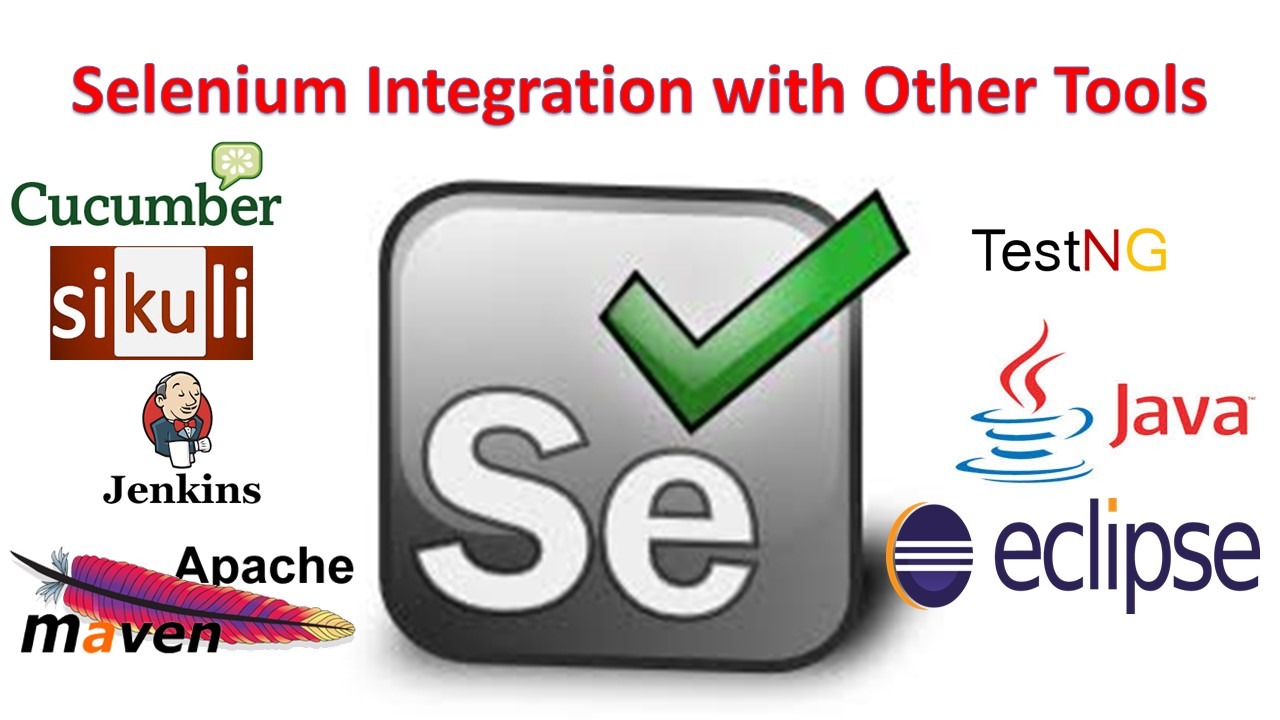Selenium integration with other software, Java for Selenium, TestNG for Selenium, Maven Integration with Selenium, and Cucumber for Selenium.
Selenium integration with other software
We have a Suite of Selenium Tools or Components for Automated Functional Testing, they are,
Selenium IDE,
Selenium RC,
Selenium WebDriver,
Selenium Grid,
In this Selenium Tool Suite, Selenium IDE is a Record and Playback tool and it is not suitable for complex Testing, next Selenium RC is outdated, next Selenium Grid is only for Test Execution, not for Test Design so we have only option is Selenium WebDriver, It is a powerful tool.
Selenium WebDriver doesn’t have any User Interface and it has API only, but it can integrate with other tools to overcome its limitations and to extend support for testing.
1) Programming Language:

Programming language is required for Automated Test Tools in order to write Test Scripts & execute Test Scripts, We use Programming syntax, programming features like Data Types, Modifiers, Variables, Operators, Control Flow, Strings, IO, Exception handling, etc… for writing Test Scripts, but programming language doesn’t recognize objects/elements to perform Test Operations, Test Tool only recognizes Elements and perform operations on Elements.
IF it is UFT like commercial Tool, Programming language (VBScript), etc, are built-in, but in Selenium WebDriver, we need to configure all required software,
Selenium WebDriver supports Java, Python, .NET, Perl, Ruby, and PHP to write Test Scripts, Select any one of those languages, for example, Java…
Install Java (JDK) Software and set Java Environment Variable path in the OS….
2) Scripts Development Platform

If We use a Commercial test tool like UFT, then we can write Test Scripts in the UFT IDE/Editor, but for Selenium WebDriver no IDE, it is an API, so IDE is required to write Test Scripts and integrate other supported components, here Select Eclipse IDE to write Selenium Test Scrips,
Download Eclipse IDE and Unzip then you can use Eclipse IDE directly, no installation of Eclipse IDE, We already installed Java software and set environment variable path, so we can write & execute Java programs in the Eclipse IDE,
3) Selenium WebDriver

Now, Create Java Project in Eclipse IDE, then download Selenium WebDriver jar files from “seleniumhq.org” and add to the Java Project, then you can write Selenium Test Cases in Eclipse IDE using Java Programming support.
4) Testing Framework

We integrate Testing Framework with Selenium in order to overcome Selenium drawbacks and to extend support for Testing, using Testing Framework like TestNG we can create Test batches, prioritize test cases, group test cases, test batch execution, parallel testing, and generate test reports.
Testing Framework selection depends on the Programming platform, if we select Java for Selenium then supported testing frameworks are JUnit and TestNG, you can use any one of these two frameworks.
Select TestNG Testing Framework as we selected Java for Programming, Install TestNG Testing Framework in Eclipse IDE, now we can work with Selenium WebDriver, Java, and TestNG from Eclipse IDE to write & execute Test scripts.
Note: These Software (Eclipse IDE, Java Programming, Selenium WebDriver, and TestNG Testing Framework) are essential to write and execute Selenium Test Cases.
we also integrate other software tools with Selenium to extend the support for Testing,
5) Maven

Maven is an Open source build automation tool for Java projects and we can use Maven for easily configure Selenium Test Environment and maintain the Test environment.
Maven works based on POM -Page object Model, Integrate Maven with Selenium, add all required Software dependencies for Selenium Testing then Maven can download and install those software, if any new versions of software available then you just update the Maven POM-XML with latest version dependencies then Maven can download and set those software.
By sharing the POM-XML file to all team members then entire team can get common selenium configuration for writing & executing Selenium Test Cases.
Note: Without Maven Integration also you can setup Selenium Environment and maintain manually, but time taking process…
6) Jenkins

Jenkins is an open source continuous integration tool, running Selenium tests in Jenkins allows us to run our tests every time our software changes and deploy the software to a new environment when the tests pass.
Jenkins can schedule our tests to run at specific time.
We can save the execution history and Test Reports and Jenkins supports Maven for building and Testing a project in continuous integration.
7) Sikuli

Sikuli is an open source tool for GUI Test Automation, Selenium supports Web Applications only for Automation, if we integrate Sikuli with Selenium, then we can automate Desktop or Windows based Applications. And Selenium can’t automate Flash objects in web pages, using sikuli integration we can automate flash objects.
8) Cucumber

Cucumber is a tool based on Behavior Driven Development (BDD) framework which is used to write acceptance tests for the web application. if we integrate Cucumber with Selenium then we can automate functional validation in easily readable and understandable format (like plain English) to Business Analysts, Developers, Testers, etc.
——————————————————————————–
Note: All these tools integration with Selenium is not mandatory for every Project, you can integrate them based on your Project Requirement, but Programming Language, Eclipse IDE, Selenium WebDriver and Testing Framework are essential.
Selenium Tutorial for Beginners
Selenium Complete Course Videos
Follow me on social media: